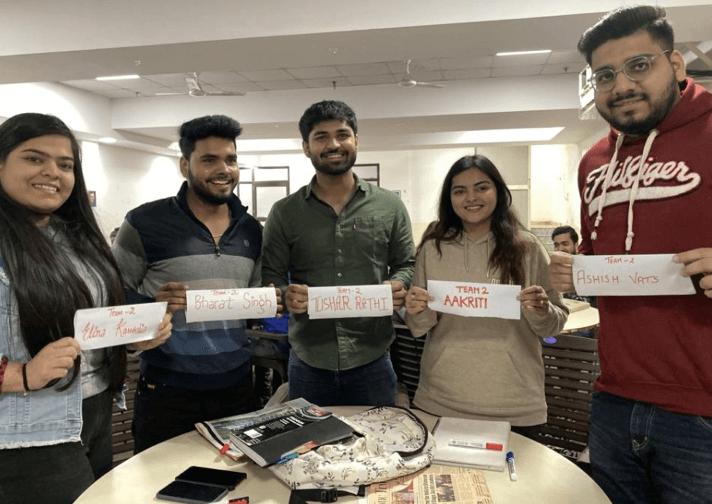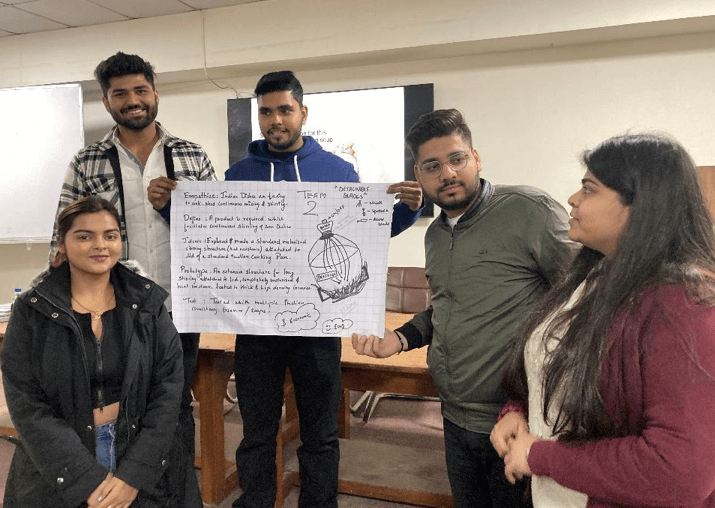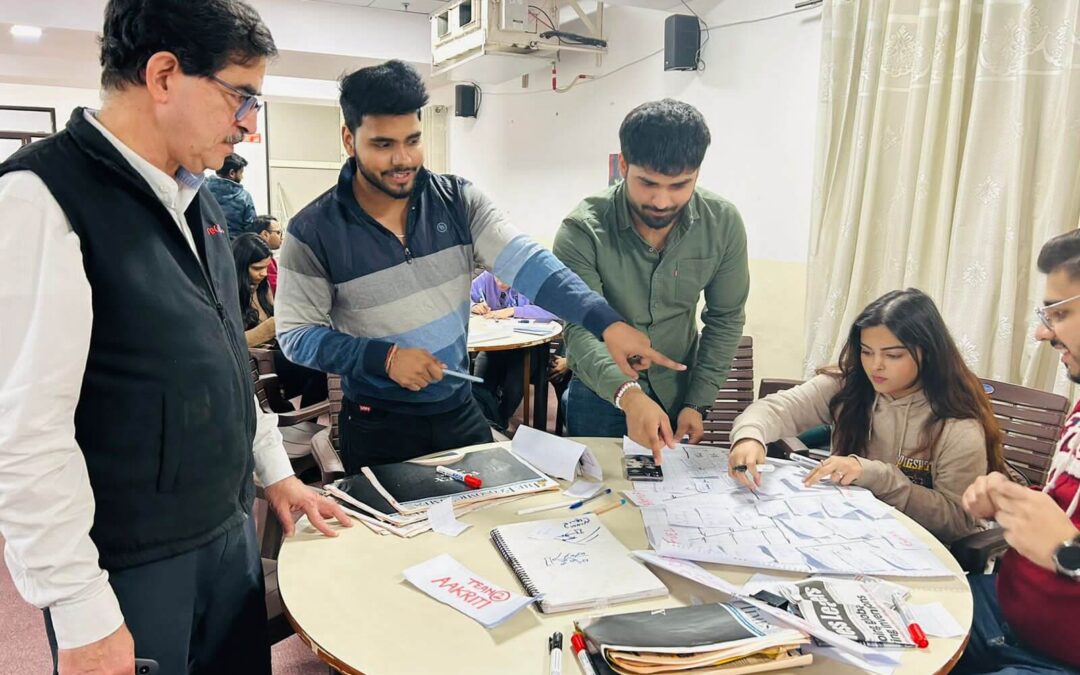In an era defined by rapid technological advancements and dynamic market landscapes, the ability to innovate has become a cornerstone of success for businesses worldwide. Traditional business models are giving way to a more human-centric approach, and at the heart of this shift lies the philosophy of design thinking. This powerful methodology is proving to be instrumental in shaping the future of business by fostering creativity, problem-solving, and a deep understanding of user needs. At Maharaja Agrasen Business School the PGDM students are being trained by Prof. Vijay Ghei, a veteran in Design Thinking. Hias workshops have not only inspired students to think out of the box but also prepare to pursue a career in this field.
Let’s understand Design Thinking in detail and get a glimpse of Prof. Ghei’s session.

The Essence of Design Thinking
At its core, design thinking is a problem-solving approach that places the end user at the center of the process. It goes beyond mere aesthetics, emphasizing empathy, experimentation, and iteration. Design thinking encourages businesses to adopt a mindset that values human experiences, ensuring that products and services not only meet functional needs but also resonate with users on an emotional level.

Transformative Impact on Business
The importance of design thinking for the future of business cannot be overstated. In a world where consumer expectations are evolving rapidly, businesses that embrace design thinking gain a competitive edge. This methodology enables companies to:
1. Foster Innovation
Design thinking encourages a culture of continuous innovation by challenging conventional wisdom and promoting creative problem-solving. Businesses that adopt this approach are better equipped to adapt to changing market dynamics and stay ahead of the curve.
2. Enhance Customer Experience
By placing the end user at the forefront of decision-making, design thinking ensures that products and services are tailored to meet the specific needs and desires of the target audience. This customer-centric approach enhances overall user satisfaction and loyalty.
3. Drive Collaboration
Design thinking thrives on cross-functional collaboration. It brings together individuals with diverse skill sets and perspectives to work towards a common goal. This collaborative spirit not only fosters creativity but also strengthens organizational cohesion.

PGDM and Design Thinking
For PGDM (Post Graduate Diploma in Management) students aspiring to excel in the ever-evolving business landscape, a comprehensive understanding of design thinking is indispensable. Many leading business schools recognize the significance of integrating design thinking into their curriculum to equip students with the skills needed to navigate the complexities of modern business.
Course Structure and Content
PGDM courses that incorporate design thinking modules expose students to a holistic learning experience. The curriculum typically covers:
- Introduction to Design Thinking Principles: Understanding the core tenets of design thinking.
- Practical Application: Hands-on projects and case studies allow students to apply design thinking methodologies to real-world business challenges.
- Interdisciplinary Collaboration: Encouraging students to work with peers from diverse academic backgrounds, fostering a cross-functional mindset.

Placement Opportunities
Businesses are actively seeking professionals who can bring a design thinking mindset to the table. PGDM graduates with a strong foundation in design thinking find themselves well-positioned for roles such as:
- Innovation Strategist
- User Experience (UX) Designer
- Product Manager
- Business Analyst
The insights gained from exploration of the 5 Golden Rules have proven to be pivotal in shaping my approach to successful transactions. Punctuality, collaboration, and embracing mistakes as integral parts of the growth process have become my guiding principles, influencing my professional journey positively.
PGDM Student, MABS
Dedicated focus on problem-solving, particularly the Five Whys technique, has equipped me with invaluable tools to dissect complex issues, understand root causes, and formulate enduring solutions. The mantra “Forget the mistake, learn the lesson. Move on!” now resonates deeply within me, fostering resilience and a dedicated commitment to continuous improvement.
PGDM Student, MABS
I am sincerely grateful for this enriching experience and am eager to apply these newfound lessons to future projects. I look forward to building meaningful relationships that not only stand the test of time but also drive unparalleled success. Thank you for the empowering and enlightening journey at Maharaja Agrasen Business School.
PGDM Student, MABS
As we navigate the intricacies of the future business landscape, design thinking emerges as a beacon of innovation and adaptability. PGDM programs at top business schools that incorporate this transformative methodology empower students to become forward-thinking leaders, ready to tackle the challenges of the business world with creativity and empathy. The integration of design thinking into the MABS PGDM course is not just a trend; it is a strategic imperative that prepares the leaders of tomorrow for success in an ever-changing environment. It also is an effort to strengthen the MABS triage pedagogy where tech savvy curriculum, strong industry academia network and beyond classroom learning through such courses gives students a unique experience of the unique business management pedagogy.
RECOMMENDED FOR YOU
MABS Admission through CAT 2024: Check Cut off, Selection Criteria and Fees
MABS, Delhi offers admission to its PGDM program through CAT score. The application form for MABS can be filled online through the MABS official website of the institute . The application fee for...
Booming IPO Market – What’s the Catch?
The stock market has long been seen as a barometer of economic health, reflecting the confidence (or concerns) of investors in the world’s future. Recently, the IPO (Initial Public Offering) market...
Management Lessons from Sunderkand
Students, Faculty and Staff of MABS had the privilege of hosting an enriching session by Dr. N.K. Kakkar, who masterfully unraveled timeless management insights from the Sundarkand chapter of the...
Maharaja Agrasen Business School Hosts Orientation Programme ‘Adhwan’ for PGDM Cohort 2026
Maharaja Agrasen Business School (MABS) proudly hosted the Orientation Programme ‘Adhwan’ held on 31st July 2024 for its newly admitted PGDM 2024-26 batch. The event followed the completion of a...
Global Immersion at Dubai
Dubai is known for its stunning skyscrapers, luxurious shopping malls, and vibrant culture. The city offers a unique blend of modernity and tradition, making it a fascinating place to visit. Dubai’s...
A Journey of Joy and Learning: Our Rakhi Business Success Story
The Maharaja Agrasen Business School's One-Day Entrepreneurship Program To allow PGDM Students to dive into the world of entrepreneurship, develop innovative business ideas, and gain hands-on...
Primary Differences between PGDM and MBA
Degree Conferred: PGDM: The PGDM program is approved by AICTE, Ministry of Education Govt. of India. This is a diploma program offered by autonomous institutions and private business schools...
Empowering Minds: Constitution Day Celebrations with Nukkad Natak
The Constitution Day Nukkad Natak organized by the PGDM students of MABS was a resounding success, leaving a lasting impact on everyone present. Through their creative and thought-provoking performance, the students demonstrated the power of street theatre as a tool for social awareness and change. As the audience departed with newfound insights, the event underscored the enduring importance of constitutional values in shaping the future of our nation.
Unlocking the Entrepreneurial Spirit Series: Story 1 – The Stationary House
The Maharaja Agrasen Business School's One-Day Entrepreneurship Program To allow PGDM Students to dive into the world of entrepreneurship, develop innovative business ideas, and gain hands-on...
Grant Thornton Bharat Hosts MABS Students for Business Analytics Sessions
Students of Maharaja Agrasen Business School visited the Grant Thornton office at Aerocity, Delhi on 14th October 2023. The visit was an insightful experience which offered an opportunity to get the...

